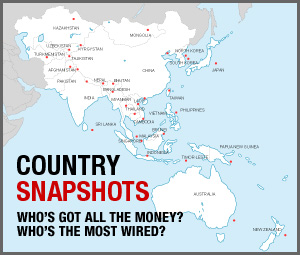
Japan
Japan’s biggest challenge over the next decade and beyond may be the simple fact that its people are disappearing.
Japan has one of the most rapidly aging populations in the world–7.1 percent of the population was aged 65 years and older in 1970, a figure that more than tripled to 22.8 percent in December 2009. This could climb to 31.8 percent by 2030, according to the National Institute of Population and Social Security Research, which would compare with 8.4 percent in India, 15.9 percent in China and 19.8 percent in the United States.
Japan’s total fertility rate (the average number of children each woman has in her lifetime) has meanwhile steadily declined from 2.16 in 1971 to 1.26 in 2005. Although it edged up to 1.37 in 2008 it’s still among the world’s lowest.
If such trends persist, the population of 127.5 million could shrink by as much as a quarter by 2050.
Successive administrations have been slow to tackle this problem, which has huge implications for the nation’s fiscal state as the number of tax-paying workers to support each retiree shrinks. But the new Democratic Party of Japan government has vowed to hammer out measures to reverse the trend, including by creating more day care centres and providing child allowances to families with children.
Critics say, however, such measures will be inadequate as the nation’s protracted economic slowdown has meant many young people have struggled to find stable employment, deterring them from starting a family.
The working age population crunch means Japan is almost certainly going to be forced to accept more immigrants, who currently make up a tiny proportion of the population. The DPJ has been more sympathetic to this idea than its predecessors, a reflection of shifting internal attitudes as seen in the growing number of international marriages–40,272 in 2007 compared with 25,626 in 1990.
On the foreign policy front, Japan will continue to wrestle with its identity and how far it should go to become a ‘normal’ country. It is barred by Article 9 of its Constitution from possessing an offensive military capability, but with the new administration under Prime Minister Yukio Hatoyama pledging to create a more equitable relationship with key ally and defence guarantor the United States, the country may again ‘reinterpret’ or eventually revise defence arrangements to allow for a more active security role.
Takehiko Kambayashi is a Tokyo-based writer and Japan correspondent for The Diplomat.










